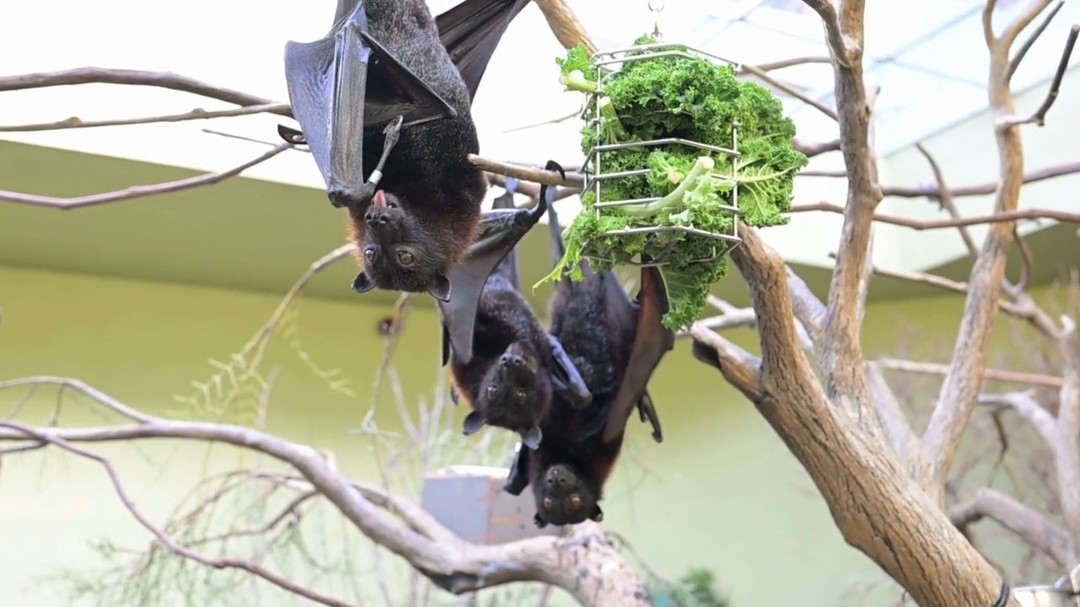- Investigate the ecological significance of Malayan Flying Foxes, emphasizing their role as pollinators and seed dispersers in Southeast Asia’s tropical ecosystems.
- Provide insights into the specific behavioral and physiological characteristics of Hey, Nutmeg, Buoy, and Maroon, resident Malayan Flying Fox females.
- Explore strategies for effective zoo management and enclosures, enhancing the wellbeing of captive Malayan Flying Foxes.
- Discuss conservation challenges and efforts, focusing on threats to Malayan Flying Fox populations and initiatives for their protection.
- Highlight the educational importance of observing Malayan Flying Foxes in zoo habitats, encouraging community engagement and raising awareness for wildlife conservation.
Malayan Flying Foxes, with their impressive wingspans reaching up to six feet, are an extraordinary species of the fruit bat family, Pteropodidae. These bats are native to the tropical forests of Southeast Asia, where they serve indispensable functions in forest ecosystems. By pollinating flowers and dispersing seeds, they facilitate forest regeneration and biodiversity. As these flying mammals traverse the canopy, pollen gathers on their fur, transporting it between flowers and promoting cross-pollination. Such interactions are crucial for maintaining the health and diversity of forested areas, demonstrating the significance of Malayan Flying Foxes in their natural habitat.
Within the community of the National Aviary, the Malayan Flying Fox females Hey, Nutmeg, Buoy, and Maroon captivate visitors and play a vital role in conservation education. Observing the nuanced behaviors of each bat, one can discern unique adaptations and social structures characteristic of their species. Hey and Nutmeg, for instance, often demonstrate a particular affinity for high branches and are keen observers of their environment, showcasing their instinctive roles in ecological surveillance within their native habitats. In contrast, Buoy and Maroon are more social, often seen grooming one another, strengthening social bonds important for group dynamics and cohesion.
Effective zoo management is critical in replicating a conducive environment for Malayan Flying Foxes. The habitat known as Canary’s Call at the National Aviary offers a semblance of their natural surroundings, featuring climbing structures and varied substrates. These considerations are essential in promoting natural behaviors and providing enrichment opportunities, which are crucial in maintaining the mental and physical health of the bats. Implementing a diet mimicking the nutritional profile they would find in the wild further supports their wellbeing, enabling visitors to witness authentic feeding behaviors.
Conservation of Malayan Flying Foxes is an urgent priority. Despite their ecological importance, these bats face significant threats due to habitat destruction, hunting, and climate change. Deforestation for agriculture, urban development, and illegal hunting for bushmeat and traditional medicine have led to population declines. Conservation initiatives are vital to protect these bats, including legal protection measures, habitat restoration projects, and community-based conservation programs. By educating the public on their ecological role and the threats they face, zoos like the National Aviary contribute to broader conservation efforts.
Moreover, displaying Malayan Flying Foxes at zoos provides invaluable educational opportunities. These animals serve as ambassadors of biodiversity, fostering public appreciation for bats and dispelling myths that often lead to their persecution. Insights into the everyday lives of Hey, Nutmeg, Buoy, and Maroon bring awareness to global conservation issues, encouraging community involvement and inspiring future generations to partake in environmental stewardship. Through interactive exhibits and educational programs, zoos play an essential role in raising awareness and funding for ongoing conservation initiatives.
Observing the Malayan Flying Foxes at the National Aviary offers a unique chance to appreciate their vital roles in nature while understanding the challenges these remarkable creatures face. By promoting their conservation and providing educational experiences, we can contribute to the safeguarding of these bats and the ecosystems they support. The interconnectedness of biodiversity and human actions underscores the importance of ongoing conservation efforts to ensure a balanced and thriving natural world.
*****
Source Description
Hey, Nutmeg, Buoy, and Maroon, we appreciate you! 🦇🖤
today is Malayan Flying Foxes are important pollinators in the tropical forests of Southeast Asia. As they use their long tongues to lick nectar from flowers, pollen collects on their fur and is carried to other plants! 🌱
Visit our lovely Malayan Flying Fox ladies in their habitat located in Canary’s Call Presented by @dollar.bank! https://www.aviary.org/birds-habitats/habitats/canarys-call/


